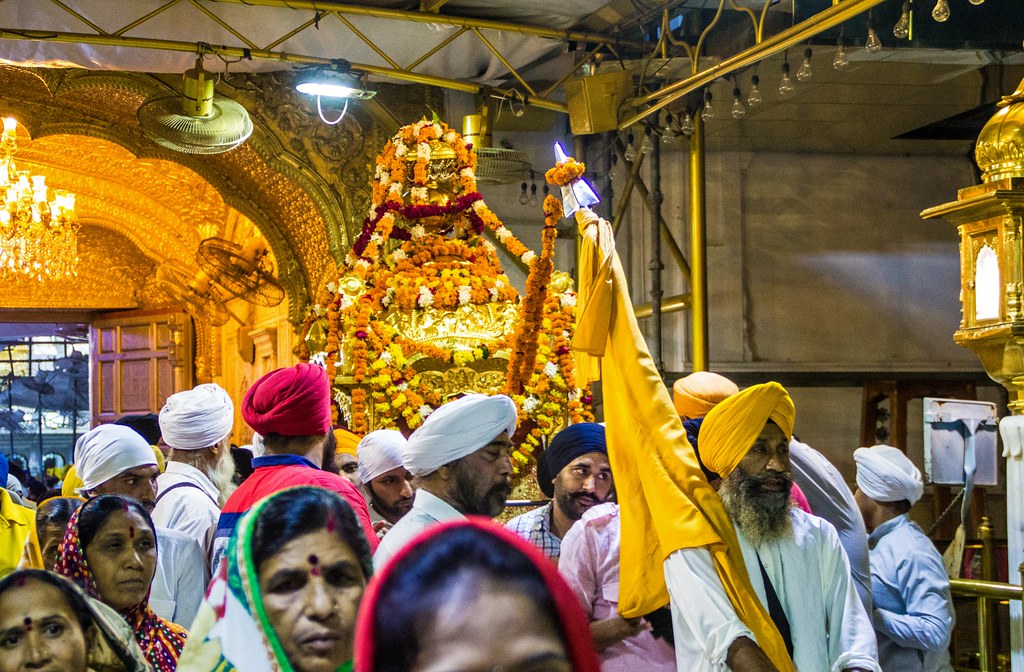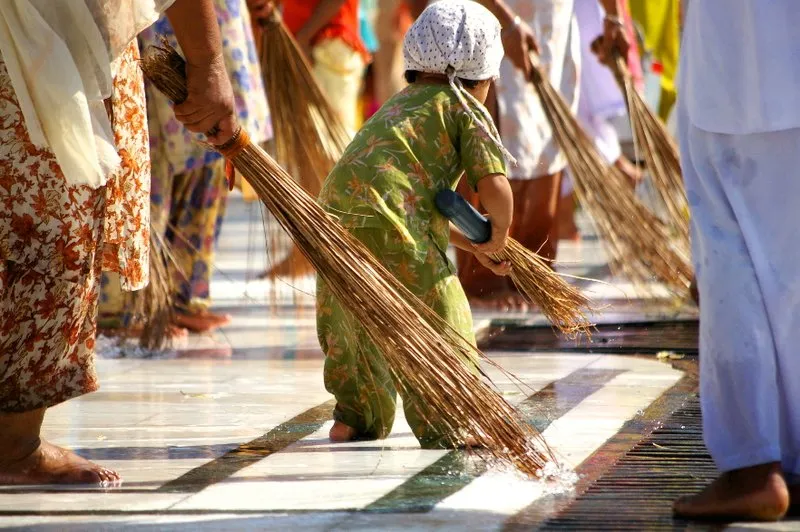
Golden Temple: The Most Celebrated Gurudwara in the World
Home > Amritsar > Golden Temple: The Most Celebrated Gurudwara in the World
Being home to one of the most famous Sikh religious places in the world, the Golden Temple, Amritsar attracts thousands of tourists every day. To plan a successful trip to the city, it is important that you cover this top attraction in the itinerary of historical places in Amritsar.
While listing the best places to visit in Amritsar, the Sikh temple comes at the top because of many reasons. Some of these are the beauty, faith and the positivity it holds. The temple is open 24 hours and welcomes people from all religions and beliefs.
The Religion
It is important to understand about Sikhism before appreciating the Golden Temple. A Sikh temple is referred to as Gurudwara which is made up of two words: “Guru” (teacher) and “Dwara” (door). Hence the word Gurudwara literally means “the door that leads to the Guru”. Guru Granth Sahib is the holy book of Sikh scriptures and any building containing the book is called a Gurudwara. The book is always placed on a raised platform due to the position and respect it holds.
The followers of Sikhism do not worship any idols or statues, but the Guru Granth Sahib acts as their Guru. The book contains sacred texts that Sikhs follow religiously.
The History
The Golden Temple and the man-made pool, encircling the main sanctum, were constructed first and then the city was built around the pool. The purpose was to keep the Sikh temple as the centre of Amritsar. The temple, also called Shri Harmandir Sahib, was destroyed multiple times by many Afghan invaders and re-built. Maharaja Ranjit Singh built the temple using marble and copper, during his reign, and the sanctum was covered in gold leaf; giving it the name “Golden Temple”. The Indian government used 500 kgs of gold during its renovation from 1995 till 1999.
The Temple
Although the Gurudwara is open 24 hours, one should visit early during the day. The atmosphere is more serene, and the air is filled with calm and spirituality as holy verses from the Guru Granth Sahib are divinely recited. Gates to the temple are open for everyone, regardless of gender, caste, creed, or religion. You are supposed to take-off your shoes at the entry where you can keep them in the “Joda ghar” (place for pair of shoes) and enter the temple barefoot (even without socks). There are water pits at the entry where you wash your feet before entering the main temple.
The gold sanctum housing the Guru Granth Sahib sits in the middle of the temple grounds. Holy texts from the book and other religious hymns are read aloud throughout the day over speakers placed around the temple and the city.
It is said that the Sarovar's (man-made pool) water has the ability to treat a wide range of spiritual, physical and emotional ailments. Remember that this is not a place for a bath. One is expected to have taken a bath before visiting the gurdwara, and the use of soap is not allowed in the Sarovar. People believe that they are cleansed of their sins and cure their ailments after taking a dip in the sanctified Sarovar.
The Gurudwara is intriguingly constructed at a lower level than the surrounding land, thereby teaching the lessons of equality and modesty. One can sit in the parikrama area, around the pool, to recite prayers and get absorbed in the beauty.
The temple glows with lights after sunset and is a sight not to miss. Hence, it is recommended to visit during different times of the day to acknowledge the beauty it offers.
Akal Takht
Akal means "Timeless," and takht means "Throne." Hence Akal Takht translates to "The throne of the Immortal (God)" and is regarded as the highest of the five takhts in Sikhism. The structure stands within the premises of Golden Temple and is considered as the Jathedar's location (spokesperson of Sikhs). The building was constructed by Guru Hargobind Singh, the sixth Sikh Guru, and is also known as "Akal Bunga”.

As a sign of respect, it is constructed at a lower height than the Golden Temple. It was made famous for its ceremonial, spiritual, and secular activities. White marble is used in the building's architecture and the dome is coated in gold leaf. Functioning as a court of law for civil and non-spiritual disputes, the Akal Takht in the Golden Temple complex serves as the religion's principal seat and supreme authority. There are four other Takhts located in Anandpur, Patna, Nanded, and Talwandi Sabo; all of which are important Sikhism pilgrimage sites.
The historic Operation Blue Star caused significant damage to the Akal Takht in 1984 and it was rebuilt later on.
The Daily Rituals
The recitals go on as scheduled throughout the day, and worshippers and guests are given Karah Prashad which is a delectable sacred offering comprised of flour, butter, and sugar.
Every night at 9.30 pm, the Guru Granth Sahib is laid to rest and a golden palanquin transports the scripture from the Golden temple to the Akal Takht (considered as the resting place). All male pilgrims and guests have the opportunity to actively engage in the worship of the holy book during this nightly service. The sacred book is transported back by Sikh Gurus and pilgrims before sunrise, at around 4.30 am every morning, for prayers and placed inside the Harmandir Sahib once more. Referred to as the Palki Sahib ceremony, it takes place two times daily.

Worshippers decorate the Guru Granth Sahib with flowers as it is brought out in the morning. Although busy, this period is incredibly quiet. The first song of the day, known as the "hukamnama," is recited at 6.30 am every day and is chosen from a random left-hand side page of the holy book.
The Langar
At the southeast corner of the temple complex, there is a huge dining area called Guru-Ka-Langar where thousands of pilgrims have meals each day after offering prayers at the Golden Temple. Frequently described as the largest free kitchen in the world, the meals are prepared by hundreds of volunteers providing free food to people of all faiths and beliefs. All devotees sit in rows on the floor and eat together without any form of discrimination. The sight and experience of a langar meal is unique and should be chosen (at least once) over having food at restaurants in Amritsar. Serving everyone from the poor to the rich, it is a humble reflection of the Sikh hospitality ideology.

To ensure that people of different religions and food habits can eat here, all food served in langar is vegetarian. It usually comprises of dal, chapati, vegetable and curd. Although paying or helping out in the kitchen is completely optional, many people offer donations in exchange for the food and volunteers also help with the washing of large number of dishes.
The Seva
Numerous volunteers work around-the-clock in the Langar (community kitchen of Gurudwara). Volunteers who donate their services for free perform the responsibilities of cleaning and maintaining the temple as well as preparing and serving the food to everybody without distinction. People offer to assist in the kitchen or temple and all of this is absolutely optional.

Many locals and pilgrims engage in sewa, or charitable work. If not in the kitchen, devotees offer their assistance at the shoe shops at the entry or with cleaning tasks. Serving food, doing the dishes, or participating in cooking are examples of this.
Donations from followers, not restricted to Sikhs, around the world cover all the expenses of maintaining the Golden Temple. It is the dedication and faith of these people that keeps everything going.
The Dress Code
Though there is no specific dress code to visit the temple, there are few general guidelines that one must follow to maintain the decorum and sanctity of the place. Since this is a sacred place of worship, there are rules that should be adhered to.
Everyone accessing the grounds is required to wear a head covering. You can cover your head with a bandana or scarf that you have on yourself. If you are not carrying one with you, you can borrow or purchase one from the shops right outside the temple.
Shoulders and legs must be covered. Shoes must be removed prior to entering the temple. There are free designated shoe drop-off locations where you will be given a token for your pair of shoes.
Socks should be taken off as well. It is recommended to dress as per the weather during your travel. Cotton clothing is advised (especially in summers and monsoons) because it might get very hot and crowded.
Visiting the temple is a spiritual experience. Upon entering the Gurdwara, the devotees consider it equivalent to meeting the Gurus in person. Hence, it is essential to be respectful of the place and its character.
Whether you are planning a short or a long trip to the city, Golden Temple should be one of the top tourist places to visit in Amritsar. One can easily find hotels near Golden temple to make their stay comfortable. There are buses connecting Amritsar Railway station to the temple that give you a free ride. Don’t wait anymore, check out hotels in Amritsar and book your travel!
Get In Touch With Our Travel Expert